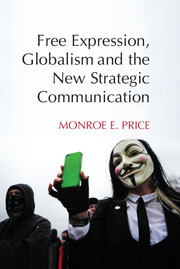Book contents
- Frontmatter
- Contents
- Acknowledgments
- 1 Moving the Needle, Filling the Streets
- 2 Strategic Communication and the Foundations of Free Expression
- 3 Narratives of Legitimacy
- 4 Strategies of the Diagnostic
- 5 Asymmetries and Strategic Communication
- 6 Strategies of System Architecture
- 7 Soft Power, Soft War
- 8 Religions and Strategic Communication
- 9 Regulating NGOs in the Market for Loyalties
- 10 Strategic Platforms
- 11 Strategic Communication and Satellite Channels
- 12 Strategies of Closure, Markers of Anxiety
- Bibliography
- Index
- References
2 - Strategic Communication and the Foundations of Free Expression
Published online by Cambridge University Press: 18 December 2014
- Frontmatter
- Contents
- Acknowledgments
- 1 Moving the Needle, Filling the Streets
- 2 Strategic Communication and the Foundations of Free Expression
- 3 Narratives of Legitimacy
- 4 Strategies of the Diagnostic
- 5 Asymmetries and Strategic Communication
- 6 Strategies of System Architecture
- 7 Soft Power, Soft War
- 8 Religions and Strategic Communication
- 9 Regulating NGOs in the Market for Loyalties
- 10 Strategic Platforms
- 11 Strategic Communication and Satellite Channels
- 12 Strategies of Closure, Markers of Anxiety
- Bibliography
- Index
- References
Summary
Let me turn, then, to my use of the term “strategic communication” to define a class of activities that significantly marks the developing global information environment. The term is now so widely used and by so many that some idiosyncratic narrowing and explanation is necessary for it to have specific meaning here. Strategic communication exists in an environment in which it is hardly possible anymore merely to communicate. The term has come to imply, a bit too generally, forms and programs of communication that are undergirded with a specific vision, programs which are strategic insofar as they serve a larger set of goals. A more directed vector for the term is “targeted communication” – communication designed with a particular schema concerning who should be reached and in what way. In some fashion and in some realms, strategic communication has become a code word for communication strategies by defense and military establishments. Strategic communication, when civilian aspects of government are the communicators, implicates soft power. When the military or defense aspect of the state is concerned, specific objectives are involved, including protecting and advancing missions and complementing command and control. Vast realms of debate and discussion of strategic communication occur in connection with business; there, strategic communication may well mean only how to achieve a firm’s (or state’s or other entity’s) objectives through astute use of modes of communication. This of course gives great leeway for defining what constitutes the “astute” relative to the circumstances and what justifies the intervention of great consulting firms. The consequence of this enlargement of category is that strategic communication is in danger of meaning and implying nothing more nor less than what an industry of autocrats and generals, prime ministers and company managers, scholars and consultants claim it to be.
- Type
- Chapter
- Information
- Publisher: Cambridge University PressPrint publication year: 2014

